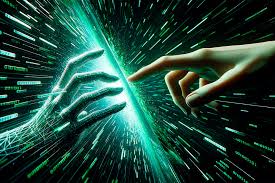Sci-fi movies often start with a “mission statement opening,” giving viewers a glimpse into the story’s theme. This includes a vast cosmic shot and an eerie score that evokes wonder and discomfort. Text displays the universe’s rules or a warning from a superior civilization, linking the viewer’s reality to the extraordinary narrative.
Simulation Theory Basics
Simulation theory suggests that our reality might be a computer simulation. This idea has roots in ancient philosophy, like Plato’s cave allegory and Descartes’ idea of an illusion-creating demon. It also connects with modern science, including quantum mechanics and limits on computing power.
The Idea of Reality as an Illusion
Simulation theory is fascinating to many people, especially in light of recent technological advancements like virtual reality and AI. Famous figures like Elon Musk and Neil deGrasse Tyson have shown interest in this idea. However, some experts, like Nick Bostrom, argue against it. Bostrom believes it’s unlikely we’re in a simulation because it would need immense computing power, which would be too costly for a game. He also points out that our consciousness might be too complex to simulate.
Problems with Simulation Theory
Simulation theory occasionally makes unsupported assumptions. It also compares our universe to video games, but this comparison doesn’t hold up well. Many video games use tricks to save computing resources; not everything in a game is fully rendered if it doesn’t serve a purpose.
The Uncanny Valley
The “Uncanny Valley” is a concept where something artificial looks so human-like that it feels eerie or unsettling. Masahiro Mori, a Japanese roboticist, first described this in the 1970s. It’s not just about robots; it can also apply to lifelike statues and CGI characters.

A study by Grabenhorst used brain imaging to see how people react to human-like and nonhuman characters. They found that the brain’s ventromedial prefrontal cortex and amygdala reacted strongly to these characteristics, which might mean we’re sensitive to detecting human-like simulators.
The Mandela Effect
The Mandela Effect is when people notice small but surprising changes in familiar details, like remembering C-3PO’s legs as gold when one is silver. Some people think these changes are due to jumps between parallel universes or attempts to hide the simulation. However, there isn’t any solid evidence to back up these claims.
The Merovingian
In the Matrix movies, The Merovingian is an old and dangerous program. He’s an expert in handling information and keeping exiles under control. His character reflects complex ideas from Kabbalah, like judgment (Gevurah) and wisdom (Chokhmah). Although The Merovingian is a fictional character, his views on free will and choice can connect to the concept of simulation theory. He suggests that if you believe in free will, it might just be an illusion.


